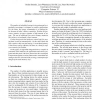Free Online Productivity Tools
i2Speak
i2Symbol
i2OCR
iTex2Img
iWeb2Print
iWeb2Shot
i2Type
iPdf2Split
iPdf2Merge
i2Bopomofo
i2Arabic
i2Style
i2Image
i2PDF
iLatex2Rtf
Sci2ools
DATE
2002
IEEE
2002
IEEE
Assigning Program and Data Objects to Scratchpad for Energy Reduction
The number of embedded systems is increasing and a remarkable percentage is designed as mobile applications. For the latter, the energy consumption is a limiting factor because of today’s battery capacities. Besides the processor, memory accesses consume a high amount of energy. The use of additional less power hungry memories like caches or scratchpads is thus common. Caches incorporate the hardware control logic for moving data in and out automatically. On the other hand, this logic requires chip area and energy. A scratchpad memory is much more energy efficient, but there is a need for software control of its content. In this paper, an algorithm integrated into a compiler is presented which analyses the application and selects program and data parts which are placed into the scratchpad. Comparisons against a cache solution show remarkable advantages between 12% and 43% in energy consumption for designs of the same memory size.1
| Added | 14 Jul 2010 |
| Updated | 14 Jul 2010 |
| Type | Conference |
| Year | 2002 |
| Where | DATE |
| Authors | Stefan Steinke, Lars Wehmeyer, Bo-Sik Lee, Peter Marwedel |
Comments (0)

